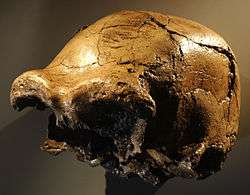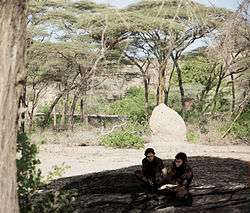Daka skull

Daka calvaria

Restoration based on evidence from the Daka Member, Ethiopia
The Daka Calvaria (a skull cap with the cranial base), specimen number BOU-VP-2/66, is a Homo erectus specimen from the Daka Member of the Bouri Formation in the Middle Awash Study Area of the Awash valley of the Ethiopia Rift.[1][2]
It was discovered in 1997 by Henry Gilbert. With it are several other Homo erectus specimens (leg bones, cranial fragments, and a toothless mandible), a large assortment of Acheulean industry stone tools,[3] and several hundred animal fossils.[4] The locality dates to about 1 million years old.
The Daka Calvaria has a cranial capacity of 995 cc (for reference, a chimp has about 375cc and a human about 1,400).
References
- ↑ Asfaw, B., Gilbert, W. H., Beyene, Y., Hart, W. K., Renne, P. R., WoldeGabriel, G. et al. (2002). "Remains of Homo erectus from Bouri, Middle Awash, Ethiopia". Nature. 416 (6878): 317–320. doi:10.1038/416317a. PMID 11907576.
- ↑ Gilbert, W. H., & Asfaw, B. (2008). Homo erectus: Pleistocene evidence from the Middle Awash, Ethiopia (Vol. 1). Berkeley: University of California Press. ISBN 978-0-520-25120-5.
- ↑ de Heinzelin, J., Clark, D., Schick, K., & Gilbert, H. (2000). The Acheulean and the Plio-Pleistocene deposits of the Middle Awash Valley Ethiopia. Tervuren, Belgium: Dept. of Geology and Mineralogy, Royal Museum of Central Africa. OCLC 46917504.
- ↑ "Middle Awash Project". Berkeley. Retrieved December 2011.
Choose Formation=Bouri to get over 700 fossils
Check date values in:|access-date=(help)
External links
- Daka Calvarium - UC Press Journal Article
This article is issued from Wikipedia - version of the 5/1/2016. The text is available under the Creative Commons Attribution/Share Alike but additional terms may apply for the media files.